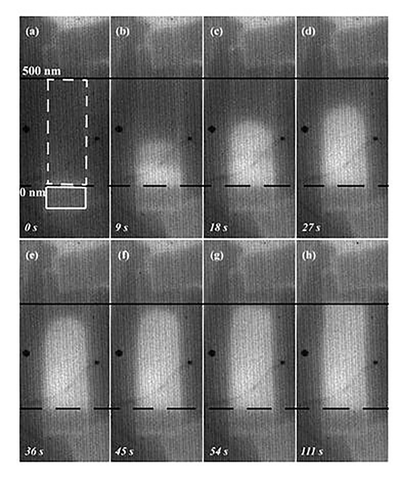
Individual frames from time-resolved IR emission-measurement images for a magnesium-iron thin film in which 4 % of the atoms are iron, exposed to hydrogen gas at 100 ºC. White areas show accumulation of hydrogen over about 2 minutes at time intervals in seconds. The film is almost completely hydrogenated within 1 minute.
The prospect of a "hydrogen economy" – in which vehicles powered by fuel cells would travel the nation's roadways emitting nothing from their tailpipes but wisps of water vapor – was making headlines 12 years ago.
In his 2003 State of the Union address, President George W. Bush issued a challenge to the nation's scientists and engineers to overcome technical obstacles so that "the first car driven by a child born today could be powered by hydrogen, and pollution free."
But today that goal remains a long way from realization -- still because of numerous technical obstacles. One of the most persistently difficult is the question of how to store hydrogen on board.
Current options for carrying enough hydrogen for about 300 miles of driving (5 – 13 kg for light-duty vehicles according to the Department of Energy, DOE) include compressing the gas to thousands of pounds per square inch, cooling it to a liquid state, or releasing it from the surfaces of porous materials that have absorbed hydrogen. The last option has obvious appeal, but typically requires long time intervals and very high temperatures to liberate the gas from its bound state.
A team of NIST scientists that worked on this problem for years has now been issued a patent for a novel alloy formulation that can eliminate many of the drawbacks of other solid-storage materials, permit rapid adsorption/desorption of H2, and operate at desirable temperatures.
As part of NIST's efforts in hydrogen research, a team was formed a decade ago as a collaboration between the Material Measurement Laboratory (MML) and Physical Measurement Laboratory (PML). It focused on magnesium (Mg), a preferred material in this line of research because it is lightweight and can adsorb enough hydrogen to constitute 7.6 % of its combined mass. But Mg alone is slow to take up hydrogen and numerous experiments have explored how to improve performance by mixing it with other metals such as nickel and titanium.
The team conducted multiple comparison tests of different formulations, including Mg and iron (Fe). Fe had not appeared particularly promising in much of the scientific literature, but there had been some indications that it could both increase the adsorption rate and perhaps reduce the temperature necessary for desorption.
"The main idea of our group," said project leader Leonid Bendersky of MML, "was to create Mg-based material that constitutes two components — the fast hydrogen diffuser and fine-size hydrogen absorber — which together will provide the needed charge/discharge kinetics. Utilizing thermodynamics of the Mg-Fe system, the properties of Mg and Fe, and phase separation during e-beam deposition, the desired structure was created and successfully tested for its hydrogenation properties."
In 2008 the MML scientists recruited PML's Edwin Heilweil, who had experience in making the kinds of sophisticated infrared emission imaging measurements needed to track the speed and adsorption/desorption efficiency of several candidate materials.*
This approach has the advantage of rapidly screening "two-dimensional combinatorial libraries" for best performance by monitoring formation of hydrides in purposely grown, variable-composition films thinner than 1 micrometer (µm, millionth of a meter).
"IR imaging is extremely useful because of the telltale thermodynamic reaction involved," Heilweil said. "As hydrogen is adsorbed onto the magnesium, there is change of IR reflectivity as the material changes from metallic to non- or semi-conductive. Looking at the sample with an infrared camera tells you how much hydrogen is being adsorbed."
When the team tested magnesium-iron thin films (about half a µm thick), they found that a combination in which iron makes up about 4% of the atoms in the storage material had remarkable properties: At normal atmospheric pressure, it could become fully charged with hydrogen in one minute at temperatures around 100 ˚C and discharged at 150 ˚C.
The group pursued a patent in September of 2012. The patent was issued in June of this year of 2015.
The performance of the NIST formulation does not meet, but is not terribly far from, the DOE targets for hydrogen storage systems. The 2020 targets call for systems that can be fully filled to 5 kg of hydrogen in 3.3 minutes and operate at temperatures in the range of 40 ˚C (or up to 60 ˚C with full exposure to direct sunlight).
NIST's patented technology may make that goal more reachable.
* "In addition to measuring heat evolution from hydrogen adsorption in films," Heilweil said, "time-resolved infrared imaging has great potential for directly monitoring chemical reactions and molecular diffusion in real time. Picosecond transmission FTIR imaging was demonstrated by Heilweil in the mid 1990's for monitoring ultrafast light-induced reaction dynamics and molecular flow in inhomogeneous materials (e.g., catalysts, solid-state mixtures, or encapsulated environments) but this technique has not yet gained popularity in the manufacturing regime."

